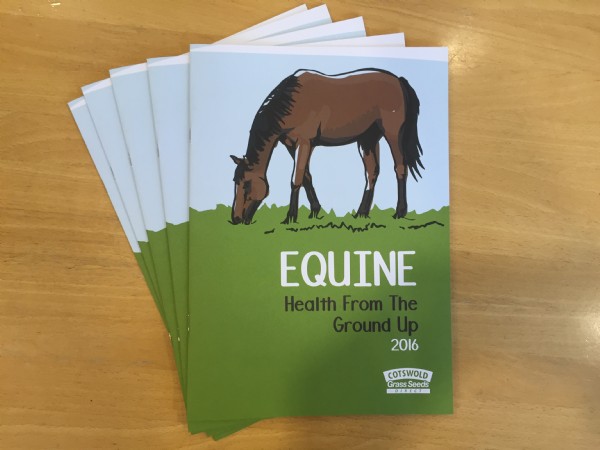

A new range of complex grass seed mixtures for the equine market has been developed to help combat some of the most common health issues affecting horses, including laminitis, gastric ulcers, developmental orthopedic disease, stereotypical behaviours and wormer resistance.
The new range includes mixes such as Mineral Rich Natural Pony Paddock, High Carb Competition Grazing, Constant Energy Weanling and Youngstock Grazing, through to Quick-Growing Paddock and Gateway Repair Mix.
The concept of their new equine range has been developed in conjunction with equine specialist, Annie Bishop, based on the latest scientific research.
In the wild, horses can roam freely to forage for specific plant species that will naturally provide them with the macro and micro nutrients, minerals and vitamins that they need and it is generally believed that wild horses had the ability to self-medicate by choosing different plants at different times of the year according to their requirements. However it has become increasingly popular to feed horses concentrates and supplements, exacerbating health issues associated with pasture management and lack of time spent eating grass or conserved grass (hay or haylage). These include laminitis, gastric ulcers, colic, respiratory diseases, mud fever, stereotypical behaviour and wormer resistance.
‘By getting the right mix of grass, legume and herb species for the land and the horse’s needs, the aim is for the horse to gain the majority, if not all, of its nutritional requirements from forage, relying less on concentrates and spending more time out in the field,’ explains Cotswold Seeds MD Ian Wilkinson.
B&W Equine Vets’ Richard Hepburn BVSc MS(Hons), CertEM(IntMed), DipACVIM, MRCVS, an FEI official treating vet at Badminton and Blenheim Horse Trials, has endorsed the new range saying:
“‘Designer forage’ for horses is a really clever, groundbreaking idea that should make a real difference to current best feeding practice for horse owners and breeders. At least 80% of the horse’s diet should be forage and there is no doubt that its quality and content can have a significant impact on their health, wellbeing and performance. Cotswold Seeds Equine is a very exciting prospect.”
Linking good health to pasture
Laminitis: The Equine Pasture and Natural Pony Paddock seed mixtures are specifically designed for laminitics and horses requiring a diet less rich in Non Structural Carbohydrates. Neither mixture contains ryegrass which has been linked with laminitis.
Gastric Ulcers: Research demonstrates that gastric ulcer prevalence is significantly higher in domesticated horses than wild horses. Acid is continually secreted into the stomach and with periods of fasting, when bucket feeding, ulceration can then occur. A high grain diet has also been linked with gastric ulcer prevalence, therefore ensuring your horse has access to forage for the majority, if not all its nutritional requirements, will minimise the risk of gastric ulcer formation.
Equine Pastern Dermatitis:Equine Pastern Dermatitis, more commonly known as mud fever is a common problem that is often difficult to treat. Establishing a strong sward that is less likely to suffer from poaching will minimise the muddy conditions associated with the development and exacerbation of mud fever.
Developmental Orthopaedic Disease (DOD): The Broodmare and Youngstock Seed Mixture contains a range of palatable species selected specifically to meet the nutritional requirements of final trimester and lactating mares as well as weanlings and yearlings. For instance, research has shown a direct link between copper deficiency in mares final trimester and increased incidence of DOD in the resultant foal, so species high in copper such as cocksfoot, yarrow and sainfoin are all included.
Colic: Providing a consistent diet that is made up of at least 60% forage and keeping concentrate consumption to a minimum has been shown to help prevent colic. By ensuring a sward contains a diverse mix of species that helps meet the nutritional requirements of your horse, concentrates can be limited.
Stereotypical Behaviours: Stereotypical and redirected behaviours such as wind-sucking, crib biting, weaving and box walking have long been associated with lack of forage and lack of free-roaming exercise. Ensuring pastures are able to provide horses with sufficient nutritional requirements and a strong enough sward to withstand the display of their natural behaviour patterns is beneficial. This is achievable by either choosing one of the standard mixes or a bespoke mix suitable for a specific land and horse’s needs.
Wormer Resistance: Resistance to the three main classes of anthelmintics (wormers) is a major concern to the industry. Some plants help reduce and manage worms. Sainfoin, chicory and birdsfoot trefoil are all proven to have natural anthelmintic properties both in fresh and conserved form.
To ensure paddocks have sufficient grazing all year round, the sward needs to include a mixture that contains species that will complement each other throughout the growing season.
Cotswolds Seeds Equine’s ‘Health from the Ground Up’ booklet provides a wealth of information on pasture feeding horses as well as a full listing of the new range of products. Request a catalogue.
Date Posted: 25th May 2016




